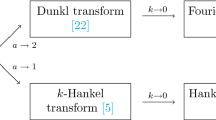Abstract
The Balian-Low theorem (BLT) is a key result in time-frequency analysis, originally stated by Balian and, independently, by Low, as: If a Gabor system \(\{e^{2\pi imbt} \, g(t-na)\}_{m,n \in \mbox{\bf Z}}\) with \(ab=1\) forms an orthonormal basis for \(L^2({\bf R}),\) then
The BLT was later extended from orthonormal bases to exact frames. This paper presents a tutorial on Gabor systems, the BLT, and related topics, such as the Zak transform and Wilson bases. Because of the fact that \((g')^{\wedge}(\gamma) = 2 \pi i \gamma \, \hat g(\gamma)\), the role of differentiation in the proof of the BLT is examined carefully. The major new contributions of this paper are the construction of a complete Gabor system of the form \(\{e^{2\pi ib_mt\} \, g(t-a_n)}\) such that \(\{(a_n,b_m)\}\) has density strictly less than 1, an Amalgam BLT that provides distinct restrictions on Gabor systems \(\{e^{2\pi imbt} \, g(t-na)\}\) that form exact frames, and a new proof of the BLT for exact frames that does not require differentiation and relies only on classical real variable methods from harmonic analysis.
Similar content being viewed by others
Author information
Authors and Affiliations
Corresponding authors
Rights and permissions
About this article
Cite this article
Benedetto, J., Heil, C. & Walnut, D. Differentiation and the Balian-Low Theorem. J Fourier Anal Appl 1, 355–402 (1994). https://doi.org/10.1007/s00041-001-4016-5
Received:
Issue Date:
DOI: https://doi.org/10.1007/s00041-001-4016-5




